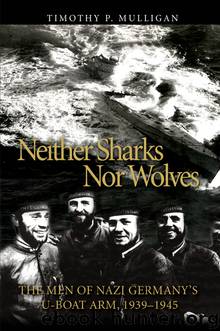Neither Sharks nor Wolves by Timothy Mulligan

Author:Timothy Mulligan [Mulligan, Timothy P.]
Language: eng
Format: epub
ISBN: 9781612510804
Publisher: Naval Institute Press
TABLE 23AGES OF U-BOAT CREWS, 1942–44 AND 1945, AND U.S. NAVY, 1945
Note: Data for the 1942–44 U-boat crewmen from Mulligan, “German U-boat Crews,” 270–71; the 611 crewmen for May 1945 represent casualties and POWs recovered for fifteen U-boats sunk or surrendered/interned at war’s end, from the same sources as used by Mulligan for 1942–44; and U.S. Navy data from chief of the Bureau of Medicine and Surgery, Navy Department, Annual Report of the Surgeon General, U.S. Navy, to the Secretary of the Navy Concerning Statistics of Diseases and Injuries in the U.S. Navy for Calendar Year 1945, 16. The German data for 1945 are biased toward a younger profile, as they omit sixteen married petty officers (certainly over 20) put ashore by U-977 in Norway before the submarine’s subsequent voyage to internment in Argentina (see Schaeffer, U-boat 977, 147–50).
These included large numbers of individual machinists, radiomen, and other technical specialists who were also trained and kept available for future duty. But in contrast to the great expansion of personnel in 1940–42, when recruits passed through an abbreviated training course and then joined the “flotilla reserves” in France for individual assignment, their counterparts in 1944–45 remained together at U-boat training facilities as a personnel pool, drilling and exercising, until their services were needed. In the spring of 1945, for example, nearly three hundred fully trained petty officers with the 1. Unterseebootsausbildungsabteilung at Plön engaged in sports and sailing while awaiting assignment, and surplus commanders and watch officers were reassigned to other duties.47
Thus, the German U-boat service did not end the war in the desperate manpower and training situation that characterized the rest of the 1945 Wehrmacht. To the extent that the U-boat campaign constituted a “children’s crusade,” that description most applies to the great expansion of the submarine fleet in 1940–42, when losses remained low. Many Allied successes and German shortcomings determined the outcome of the Battle of the Atlantic; the ages and relative experience of Germany’s U-boat crews did not figure in the decision.
But sheep need not be lambs to be slaughtered. Periods of heavy casualties formed part of the rhythm of the Atlantic campaign from 1939 through 1943, and in that context Dönitz’s read of May 1943 as a setback rather than a irreversible catastrophe can be understood. Similarly, the sacrifice of lives to buy time sometimes represents a military necessity, and the U-boats certainly tied down a disproportionate amount of Allied forces in 1944–45.48 But whether that mission justified the massive bloodletting of a technologically and tactically outmatched U-boat force after the summer of 1943 must weigh heavily in the final assessment of Dönitz.
Download
This site does not store any files on its server. We only index and link to content provided by other sites. Please contact the content providers to delete copyright contents if any and email us, we'll remove relevant links or contents immediately.
| Automotive | Engineering |
| Transportation |
The Truth About The Titanic by Archibald Gracie(916)
1805 by Richard Woodman(851)
05 Marine by Tom Clancy(840)
The Ship of Dreams by Gareth Russell(753)
The Art of Rigging by George Biddlecombe(749)
Marine by Tom Clancy(709)
Patriot Pirates by Robert H. Patton(708)
Villains of All Nations by Marcus Rediker(706)
Batavia by Peter FitzSimons(680)
The Last Time Around Cape Horn by William F. Stark(674)
8.4 by Peter Hernon(654)
The Imperial Japanese Navy in the Pacific War by Mark Stille(626)
Pirate Hunter of the Caribbean by David Cordingly(614)
Unsinkable: The Full Story of the RMS Titanic by Daniel Allen Butler(600)
Sailing Alone Around the World (Barnes & Noble Classics Series) by Joshua Slocum(582)
Voices from the Titanic by Geoff Tibballs(563)
The Perfect Storm: A True Story of Men Against the Sea by Sebastian Junger(552)
The Last Night on the Titanic by Veronica Hinke(551)
01 The Sea Hunters by Clive Cussler & Craig Dirgo(544)
